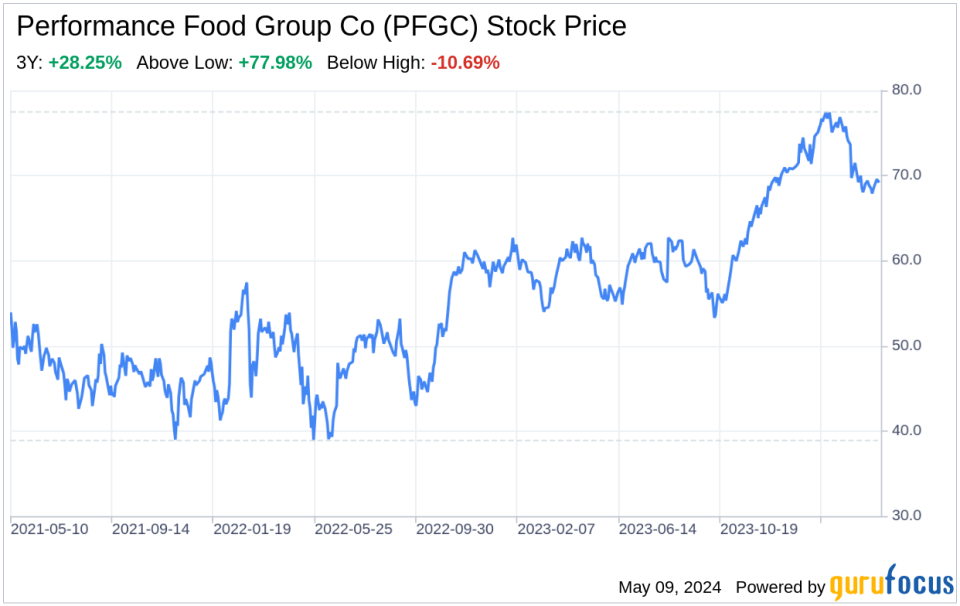Decoding Performance Food Group Co (PFGC): A Strategic SWOT Insight
Performance Food Group Co (NYSE:PFGC) maintains a significant presence in the food-service distribution industry with a diverse product portfolio and strategic acquisitions.
Despite robust market share and expansion efforts, PFGC faces intense competition and industry-specific challenges.
Opportunities for growth in the convenience and vending segments present potential avenues for PFGC's continued expansion.
Threats such as economic downturns, supply chain disruptions, and increased regulatory pressures could impact PFGC's operational efficiency and profitability.
Performance Food Group Co (NYSE:PFGC), a leading food-service distributor in the United States, filed its 10-Q report on May 8, 2024. The company, known for its extensive product offerings and services to a variety of customers including restaurants, institutions, and convenience stores, reported a total lease cost of $94.0 million for the three months ended March 30, 2024, compared to $84.1 million for the same period in the previous year. Over nine months, the total lease cost increased from $243.0 million to $275.4 million. This financial overview indicates a rise in operating expenses related to lease assets, which could impact the company's profitability and operational efficiency.

Strengths
Market Position and Diversification: PFGC's strong market position as the third-largest food-service distributor in the U.S. is a testament to its robust product portfolio and service offerings. The company's diversification strategy, which includes the acquisition of Eby-Brown in 2019 and Core-Mark in 2021, has allowed it to tap into the convenience store segment, thereby expanding its market reach and reducing reliance on any single customer type or product category. This diversification not only enhances PFGC's resilience against market volatility but also positions it to capitalize on various consumer trends across its operating segments.
Strategic Acquisitions: PFGC's growth strategy includes strategic acquisitions that have historically contributed positively to its revenue streams and market share. The acquisitions of Eby-Brown and Core-Mark have not only expanded PFGC's footprint in the convenience store segment but also provided access to new customers and markets. These acquisitions have been integrated successfully, demonstrating PFGC's capability in enhancing its value proposition through inorganic growth.
Weaknesses
Operating Margin Pressure: PFGC operates in a low-margin industry, which is evident from the increase in total lease costs as reported in the recent 10-Q filing. The rise in operating lease costs, finance lease costs, and short-term lease costs could squeeze the already thin margins, making it imperative for PFGC to manage its expenses diligently to maintain profitability. The company's ability to navigate these cost pressures will be crucial in sustaining its competitive edge.
Dependence on Third-Party Suppliers: The company's reliance on third-party suppliers for its vast array of products introduces risks related to supply chain disruptions and price volatility. As noted in the 10-Q filing, PFGC's profitability can be directly affected by cost inflation and deflation, which are influenced by supplier pricing practices and external economic factors. This dependence necessitates robust supplier relationship management and contingency planning to mitigate potential supply chain challenges.
Opportunities
Expansion in Convenience and Vending Segments: PFGC's foray into the convenience and vending segments through its acquisitions presents significant growth opportunities. The convenience segment, in particular, has shown resilience during economic downturns, and PFGC's established distribution network can be leveraged to further penetrate this market. Additionally, the vending segment offers potential for expansion as consumer preferences shift towards on-the-go and contactless purchasing options.
Technological Advancements: The company's reliance on technology for operations presents opportunities to invest in innovative solutions that can streamline processes, enhance customer service, and improve efficiency. As noted in the 10-Q filing, PFGC is focused on implementing new technology, which could lead to cost savings and improved margins over time. Embracing digital transformation can also position PFGC as a forward-thinking leader in the food-service distribution industry.
Threats
Economic and Consumer Spending Fluctuations: Economic factors such as inflation and downturns can negatively impact consumer confidence and discretionary spending, as highlighted in the 10-Q filing. PFGC's performance is closely tied to the health of the restaurant industry and consumer spending patterns. An economic slowdown could lead to reduced demand for PFGC's products and services, adversely affecting its revenue and profitability.
Intense Competition: The food-service distribution industry is highly competitive, with PFGC facing competition from both national and regional players. As the company operates in a low-margin environment, it must continuously innovate and differentiate its offerings to maintain market share. The intense competition also necessitates strategic pricing, which could further compress margins if not managed effectively.
In conclusion, Performance Food Group Co (NYSE:PFGC) exhibits a strong market position with strategic diversification and growth through acquisitions. However, the company must navigate the challenges of operating in a low-margin industry, manage its reliance on third-party suppliers, and address the threats posed by economic fluctuations and intense competition. By capitalizing on opportunities in the convenience and vending segments and leveraging technological advancements, PFGC can continue to strengthen its competitive advantage and drive long-term growth.
This article, generated by GuruFocus, is designed to provide general insights and is not tailored financial advice. Our commentary is rooted in historical data and analyst projections, utilizing an impartial methodology, and is not intended to serve as specific investment guidance. It does not formulate a recommendation to purchase or divest any stock and does not consider individual investment objectives or financial circumstances. Our objective is to deliver long-term, fundamental data-driven analysis. Be aware that our analysis might not incorporate the most recent, price-sensitive company announcements or qualitative information. GuruFocus holds no position in the stocks mentioned herein.
This article first appeared on GuruFocus.
